A New Remote Sensing Approach to Enrich Hydropower Dams’ Information and Assess Their Impact Distances: A Case Study in the Mekong River Basin
Abstract
1. Introduction
2. Materials and Methods
2.1. Data Used
2.1.1. Remote Sensing Data
2.1.2. MRB Hydropower Dam Data
2.2. The New Remote Sensing Approach
2.2.1. Differentiated Above Dam Area and Below Dam Area
2.2.2. Construction Start and Completion Timing Determination
2.2.3. Entropy-Based Hydropower Dam Influencing Distance Above and Below the Dam Areas
3. Results
3.1. Timing Determination
3.2. Correlation Analyses and Accuracy Assessment for Timing Determination
3.3. Hydropower Dam’s Impact Extent Above and Below the Dam Areas
3.4. Dam Capacity and Dam Influencing Distance
4. Discussion
4.1. Possible Factors Causing Differentiated Impacts at Different Stages
4.2. Optimal Area, Indicator, and Buffer Radius Size Combination for Timing Determination
4.3. Approach Improvement
4.4. Applications in Change Detection, Ecology, and Hydrology
5. Conclusions
Author Contributions
Funding
Conflicts of Interest
References
- Lehner, B.; Reidy Liermann, C.; Revenga, C.; Vorosmarty, C.; Fekete, B.; Crouzet, P.; Doll, P.; Endejan, M.; Frenken, K.; Magome, J.; et al. Global Reservoir and Dam Database, Version 1 (GRanDv1): Dams, Revision 01; NASA Socioeconomic Data and Applications Center (SEDAC): Palisades, NY, USA, 2011. [Google Scholar]
- Zarfl, C.; Lumsdon, A.E.; Berlekamp, J.; Tydecks, L.; Tockner, K. A global boom in hydropower dam construction. Aquat. Sci. 2014, 77, 161–170. [Google Scholar] [CrossRef]
- Rahaman, M.M.; Varis, O. Integrated water management of the Brahmaputra basin: Perspectives and hope for regional development. Nat. Resour. Forum 2009, 33, 60–75. [Google Scholar] [CrossRef]
- Wang, L.; Xu, L.; Wang, X.; You, W.J.; Tan, W. Knowledge portal construction and resources integration for a large scale hydropower dam. Syst. Res. Behav. Sci. 2009, 26, 357–366. [Google Scholar] [CrossRef]
- Mulligan, M.; Saenz-Cruz, L.; van Soesbergen, A.; Smith, V.T.; Zurita, L. Global Dams Database and Geowiki: Version 1. 2009. Available online: http://globaldamwatch.org/good2/ (accessed on 1 October 2019).
- Byers, L.; Friedrich, J.; Hennig, R.; Kressig, A.; Li, X.; Mccormick, C.; Valeri, L.M. Global Database of Power Plants; World Resources Institute: Washington, DC, USA, 2019. [Google Scholar]
- Lehner, B.; Fekete, B.; Reidy, C.; Vörösmarty, C.J. Global Reservoir and Dam Database (GRanD); NASA: Palisades, NY, USA, 2010. [Google Scholar]
- Toth, C.; Jóźków, G. Remote sensing platforms and sensors: A survey. ISPRS J. Photogramm. Remote Sens. 2016, 115, 22–36. [Google Scholar] [CrossRef]
- Arias, M.E.; Cochrane, T.A.; Piman, T.; Kummu, M.; Caruso, B.S.; Killeen, T.J. Quantifying changes in flooding and habitats in the Tonle Sap Lake (Cambodia) caused by water infrastructure development and climate change in the Mekong Basin. J. Environ. Manag. 2012, 112, 53–66. [Google Scholar] [CrossRef] [PubMed]
- Kuenzer, C.; van Beijma, S.; Gessner, U.; Dech, S. Land surface dynamics and environmental challenges of the Niger Delta, Africa: Remote sensing-based analyses spanning three decades (1986–2013). Appl. Geogr. 2014, 53, 354–368. [Google Scholar] [CrossRef]
- El Bastawesy, M.; Gabr, S.; Mohamed, I. Assessment of hydrological changes in the Nile River due to the construction of Renaissance Dam in Ethiopia. Egypt. J. Remote Sens. Space Sci. 2015, 18, 65–75. [Google Scholar] [CrossRef]
- Velpuri, N.M.; Senay, G.B. Assessing the potential hydrological impact of the Gibe III Dam on Lake Turkana water level using multi-source satellite data. Hydrol. Earth Syst. Sci. 2012, 16, 3561–3578. [Google Scholar] [CrossRef]
- Xu, X.; Tan, Y.; Yang, G.; Li, H.; Su, W. Impacts of China’s Three Gorges Dam Project on net primary productivity in the reservoir area. Sci. Total Environ. 2011, 409, 4656–4662. [Google Scholar] [CrossRef]
- Ouyang, W.; Hao, F.H.; Zhao, C.; Lin, C. Vegetation response to 30 years hydropower cascade exploitation in upper stream of Yellow River. Commun. Nonlinear Sci. Numer. Simul. 2010, 15, 1928–1941. [Google Scholar] [CrossRef]
- Tantianuparp, P.; Shi, X.; Zhang, L.; Balz, T.; Liao, M. Characterization of landslide deformations in three Gorges area using multiple inSAR data stacks. Remote Sens. 2013, 5, 2704–2719. [Google Scholar] [CrossRef]
- Zhou, W.; Li, S.; Zhou, Z.; Chang, X. Remote sensing of deformation of a high concrete-faced rockfill dam using InSAR: A study of the Shuibuya dam, China. Remote Sens. 2016, 8, 255. [Google Scholar] [CrossRef]
- Aguiar, F.C.; Martins, M.J.; Silva, P.C.; Fernandes, M.R. Riverscapes downstream of hydropower dams: Effects of altered flows and historical land-use change. Landsc. Urban Plan. 2016, 153, 83–98. [Google Scholar] [CrossRef]
- Lin, Z.; Qi, J. Hydro-dam—A nature-based solution or an ecological problem: The fate of the Tonlé Sap Lake. Environ. Res. 2017, 158, 24–32. [Google Scholar] [CrossRef]
- Winemiller, K.O.; McIntyre, P.B.; Castello, L.; Fluet-Chouinard, E.; Giarrizzo, T.; Nam, S.; Baird, I.G.; Darwall, W.; Lujan, N.K.; Harrison, I.; et al. Balancing hydropower and biodiversity in the Amazon, Congo, and Mekong. Science 2016, 351, 128–129. [Google Scholar] [CrossRef]
- Zhao, Q.; Liu, S.; Deng, L.; Dong, S.; Yang, Z.; Yang, J. Landscape change and hydrologic alteration associated with dam construction. Int. J. Appl. Earth Obs. Geoinf. 2012, 16, 17–26. [Google Scholar] [CrossRef]
- WLE. Dataset on the Dams of the Irrawaddy, Mekong, Red and Salween River Basins; WLE: Vientiane, Laos, 2017. [Google Scholar]
- Grumbine, R.E.; Dore, J.; Xu, J. Mekong hydropower: Drivers of change and governance challenges. Front. Ecol. Environ. 2012, 10, 91–98. [Google Scholar] [CrossRef]
- Molle, F.; Foran, T.; Käkönen, M. Contested waterscapes in the mekong region: Hydropower, livelihoods and governance. In Contested Waterscapes Mekong Region: Hydropower, Livelihoods and Governance; Earthscan: London, UK, 2012; pp. 1–426. ISBN 9781849770. [Google Scholar]
- Eastham, J.; Mpelasoka, F.; Ticehurst, C.; Dyce, P.; Ali, R.; Kirby, M. Mekong River Basin Water Resources Assessment: Impacts of Climate Change; CiteSeer: University Park, PA, USA, 2008; p. 153. [Google Scholar]
- Keskinen, M.; Chinvanno, S.; Kummu, M.; Nuorteva, P.; Snidvongs, A.; Varis, O.; Västilä, K. Climate change and water resources in the lower Mekong River Basin: Putting adaptation into the context. J. Water Clim. Chang. 2010, 1, 103–117. [Google Scholar] [CrossRef]
- Lauri, H.; De Moel, H.; Ward, P.J.; Räsänen, T.A.; Keskinen, M.; Kummu, M. Future changes in Mekong River hydrology: Impact of climate change and reservoir operation on discharge. Hydrol. Earth Syst. Sci. 2012, 16, 4603–4619. [Google Scholar] [CrossRef]
- Ringler, C. Optimal Water Allocation in the Mekong River Basin; ZEF Discussion Papers on Development Policy: Bonn, Germany, 2001. [Google Scholar]
- Food and Agriculture Organization of the United Nations (FAO). Mekong River Basin; FAO: Rome, Italy, 2011. [Google Scholar]
- Mekong River Commission (MRC). Annual Report 2017; MRC: Phnom Penh, Cambodia, 2017. [Google Scholar]
- Mekong River Commission (MRC). State of the Basin Report 2003; MRC: Phnom Penh, Cambodia, 2003. [Google Scholar]
- Mekong River Commission (MRC). State of the Basin Report 2010; MRC: Phnom Penh, Cambodia, 2010. [Google Scholar]
- Baran, E.; Myschowoda, C. Dams and fisheries in the Mekong Basin. Aquat. Ecosyst. Health Manag. 2009, 12, 227–234. [Google Scholar] [CrossRef]
- Ferguson, J.W.; Healey, M.; Dugan, P.; Barlow, C. Potential effects of dams on migratory fish in the Mekong River: Lessons from salmon in the fraser and Columbia Rivers. Environ. Manag. 2011, 47, 141–159. [Google Scholar] [CrossRef] [PubMed]
- Li, J.; Dong, S.; Peng, M.; Yang, Z.; Liu, S.; Li, X.; Zhao, C. Effects of damming on the biological integrity of fish assemblages in the middle Lancang-Mekong River basin. Ecol. Indic. 2013, 34, 94–102. [Google Scholar] [CrossRef]
- Lu, X.X.; Li, S.; Kummu, M.; Padawangi, R.; Wang, J.J. Observed changes in the water flow at Chiang Saen in the lower Mekong: Impacts of Chinese dams? Quat. Int. 2014, 336, 145–157. [Google Scholar] [CrossRef]
- Räsänen, T.A.; Koponen, J.; Lauri, H.; Kummu, M. Downstream hydrological impacts of hydropower development in the Upper Mekong Basin. Water Resour. Manag. 2012, 26, 3495–3513. [Google Scholar] [CrossRef]
- Gorelick, N. Google Earth Engine. In Proceedings of the AGU Fall Meeting, San Francisco, CA, USA, 3–7 December 2012; Volume 15, p. 11997. [Google Scholar]
- Gorelick, N.; Hancher, M.; Dixon, M.; Ilyushchenko, S.; Thau, D.; Moore, R. Google Earth Engine: Planetary-scale geospatial analysis for everyone. Remote Sens. Environ. 2017, 202, 18–27. [Google Scholar] [CrossRef]
- Takaku, J.; Tadono, T.; Tsutsui, K. Generation of high resolution global DSM from ALOS PRISM. Int. Arch. Photogramm. Remote Sens. Spat. Inf. Sci. 2014, 40, 243–248. [Google Scholar] [CrossRef]
- Tadono, T.; Ishida, H.; Oda, F.; Naito, S.; Minakawa, K.; Iwamoto, H. Precise Global DEM Generation by ALOS PRISM. ISPRS Ann. Photogramm. Remote Sens. Spat. Inf. Sci. 2014, II–4, 71–76. [Google Scholar] [CrossRef]
- Brown, C.E. Coefficient of Variation. In Applied Multivariate Statistics in Geohydrology and Related Sciences; Springer: Berlin/Heidelberg, Germany, 1998; pp. 155–157. [Google Scholar]
- Bai, J. Estimation of a change point in multiple regression models. Rev. Econ. Stat. 1997, 79, 551–563. [Google Scholar] [CrossRef]
- Bai, J. Estimating multiple breaks one at a time. Econ. Theory 1997, 13, 315. [Google Scholar] [CrossRef]
- Bai, J. Least squares estimation of a shift in linear processes. J. Time Ser. Anal. 1994, 15, 453–472. [Google Scholar] [CrossRef]
- Bai, J.; Perron, P. Estimating and testing linear models with multiple structural changes. Econometrica 1998, 66, 47. [Google Scholar] [CrossRef]
- Boamah, N.A.; Loudon, G.; Watts, E.J. Structural breaks in the relative importance of country and industry factors in African stock returns. Q. Rev. Econ. Financ. 2017, 63, 79–88. [Google Scholar] [CrossRef]
- Hansen, B.E. The New Econometrics of Structural Change: Dating Breaks in U.S. Labor Productivity. J. Econ. Perspect. 2001, 15, 117–128. [Google Scholar] [CrossRef]
- Jouini, J.; Boutahar, M. Structural breaks in the U.S. inflation process: A further investigation. Appl. Econ. Lett. 2003, 10, 985–988. [Google Scholar] [CrossRef]
- Perron, P.; Zhu, X. Structural breaks with deterministic and stochastic trends. J. Econom. 2005, 129, 65–119. [Google Scholar] [CrossRef]
- Rudebusch, G.D.; Wu, T. Accounting for a shift in term structure behavior with no-arbitrage and macro-finance models. J. Money Credit Bank. 2007, 39, 395–422. [Google Scholar] [CrossRef]
- Wallack, J.S. Structural Breaks in Indian Macroeconomic Data. Econ. Polit. Wkly. 2003, 46, 4312–4315. [Google Scholar]
- Kleiber, C.; Hornik, K.; Leisch, F.; Zeileis, A. Strucchange: An r package for testing for structural change in linear regression models. J. Stat. Softw. 2002, 7, 1–38. [Google Scholar]
- Zhao, Q.; Liu, S.; Deng, L.; Dong, S.; Yang, Z.; Liu, Q. Determining the influencing distance of dam construction and reservoir impoundment on land use: A case study of Manwan Dam, Lancang River. Ecol. Eng. 2013, 53, 235–242. [Google Scholar] [CrossRef]
- Cloude, S.; Pottier, E. An entropy based classification scheme for land applications of polarimetric SAR. IEEE Trans. Geosci. Remote Sens. 1997, 35, 68–78. [Google Scholar] [CrossRef]
- Jat, M.K.; Garg, P.K.; Khare, D. Monitoring and modelling of urban sprawl using remote sensing and GIS techniques. Int. J. Appl. Earth Obs. Geoinf. 2008, 10, 26–43. [Google Scholar] [CrossRef]
- Maselli, F.; Conese, C.; Petkov, L. Use of probability entropy for the estimation and graphical representation of the accuracy of maximum likelihood classifications. ISPRS J. Photogramm. Remote Sens. 1994, 49, 13–20. [Google Scholar] [CrossRef]
- Manderscheid, L. V Significance Levels. 0.05, 0.01, or? J. Farm. Econ. 1965, 47, 1381–1385. [Google Scholar] [CrossRef]
- Huete, A.R.; Liu, H.; van Leeuwen, W.J.D. The use of vegetation indices in forested regions: Issues of linearity and saturation. In Proceedings of the IEEE International Geoscience and Remote Sensing Symposium Proceedings, Remote Sensing—A Scientific Vision for Sustainable Development, Singapore, 3–8 August 1997; Volume 4, pp. 1966–1968. [Google Scholar]
- Vina, A.; Henebry, G.M.; Gitelson, A.A. Satellite monitoring of vegetation dynamics: Sensitivity enhancement by the wide dynamic range vegetation index. Geophys. Res. Lett. 2004, 31, 1–4. [Google Scholar] [CrossRef]
- Aguilar-Amuchastegui, N.; Henebry, G.M. Characterizing tropical forest spatio-temporal heterogeneity using the wide dynamic range vegetation index (WDRVI). Int. J. Remote Sens. 2008, 29, 7285–7291. [Google Scholar] [CrossRef]
- Räsänen, T.A.; Someth, P.; Lauri, H.; Koponen, J.; Sarkkula, J.; Kummu, M. Observed river discharge changes due to hydropower operations in the Upper Mekong Basin. J. Hydrol. 2017, 545, 28–41. [Google Scholar] [CrossRef]
- Schilt, C.R. Developing fish passage and protection at hydropower dams. Appl. Anim. Behav. Sci. 2007, 104, 295–325. [Google Scholar] [CrossRef]
- Hay, B.J. Sediment and water discharge rates of Turkish Black Sea rivers before and after hydropower dam construction. Environ. Geol. 1994, 23, 276–283. [Google Scholar] [CrossRef]
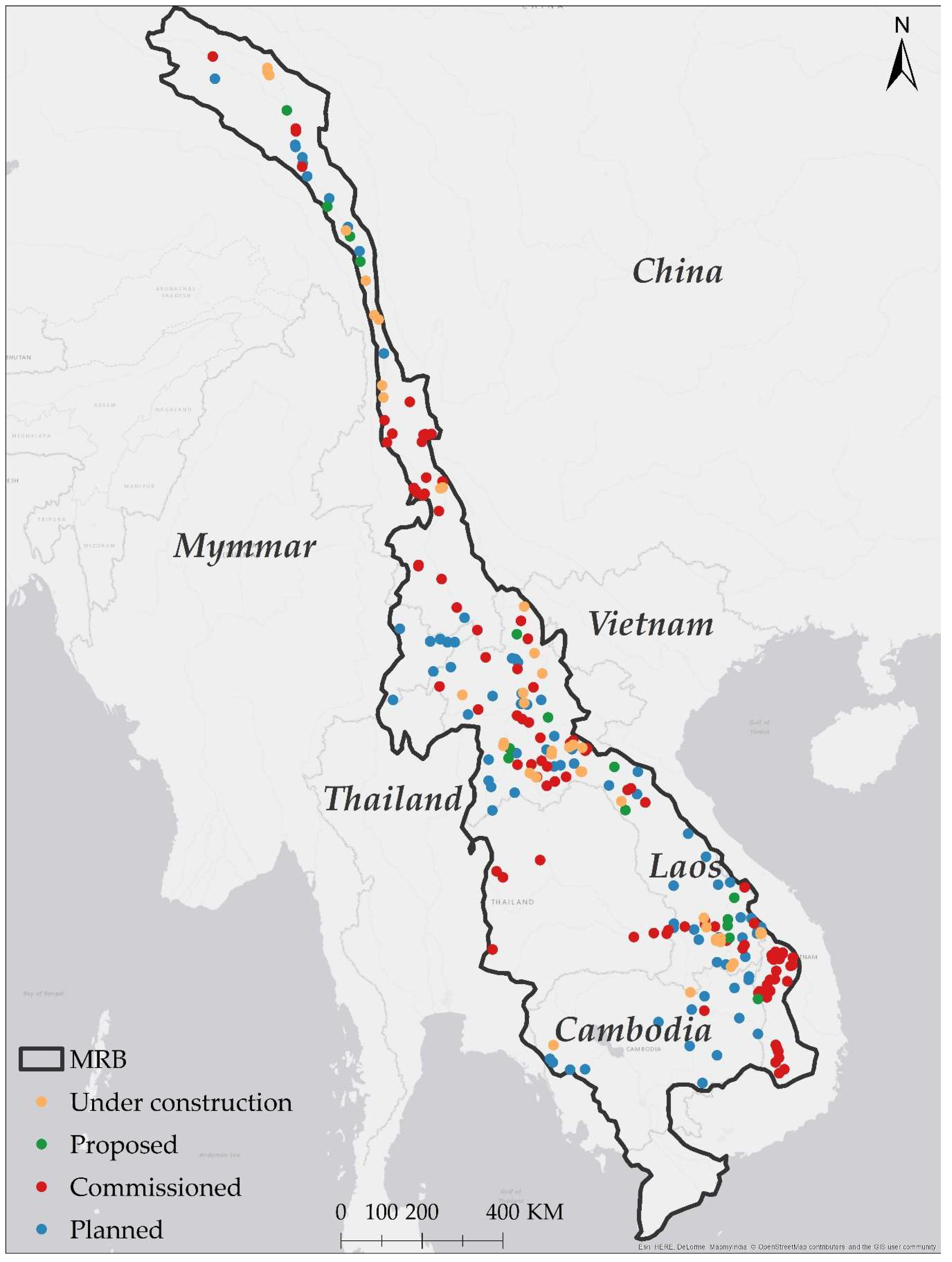
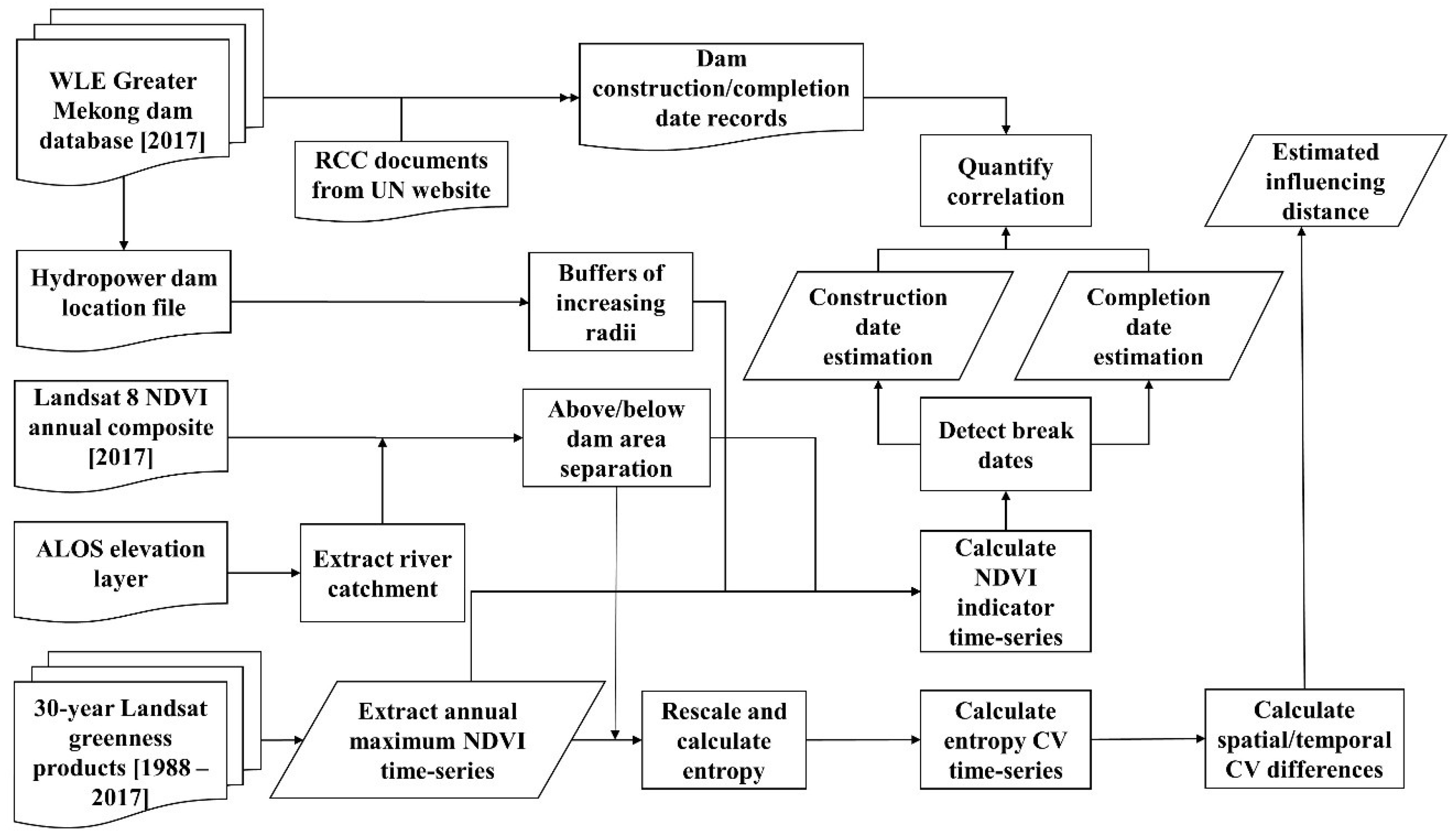
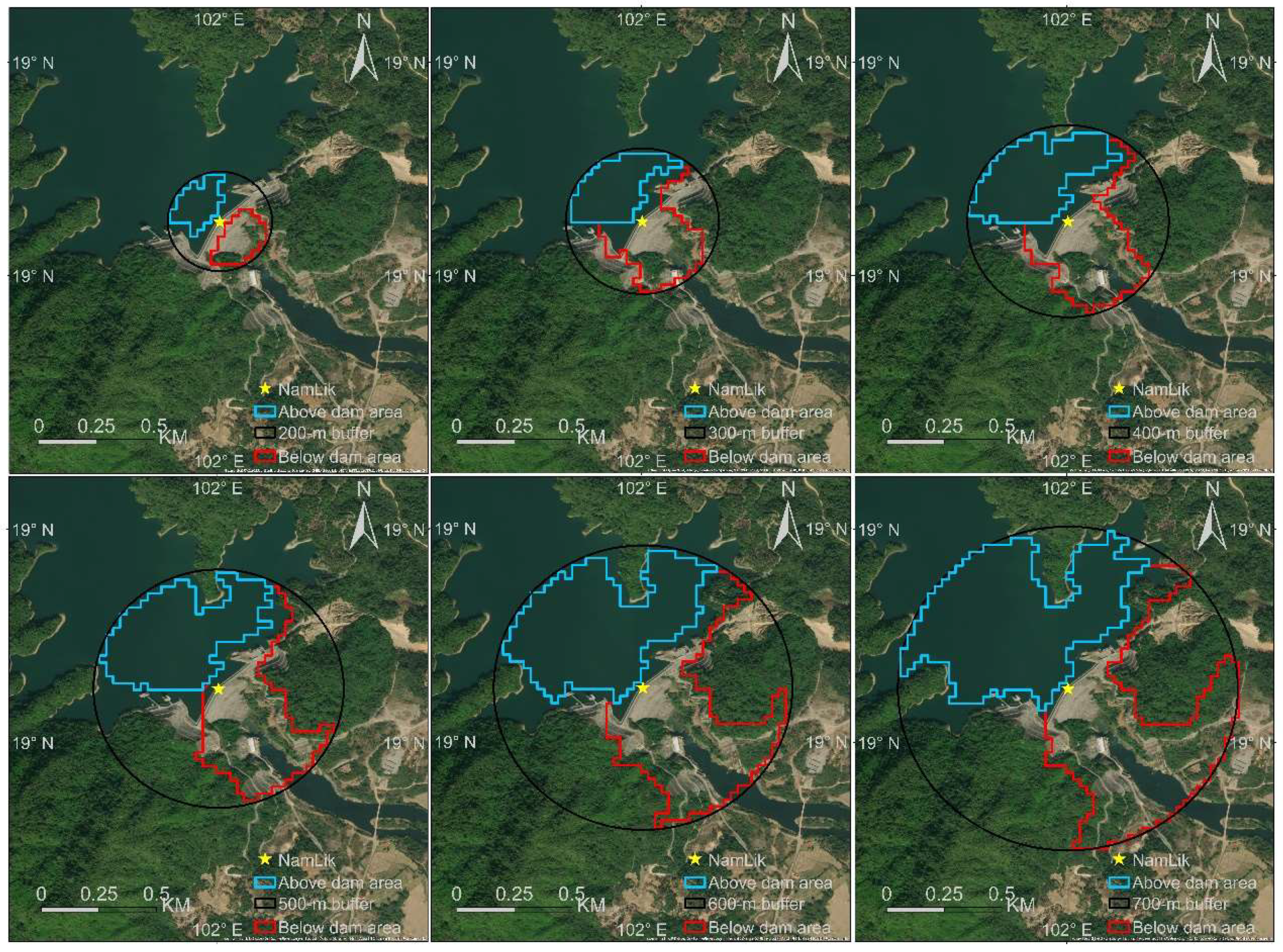
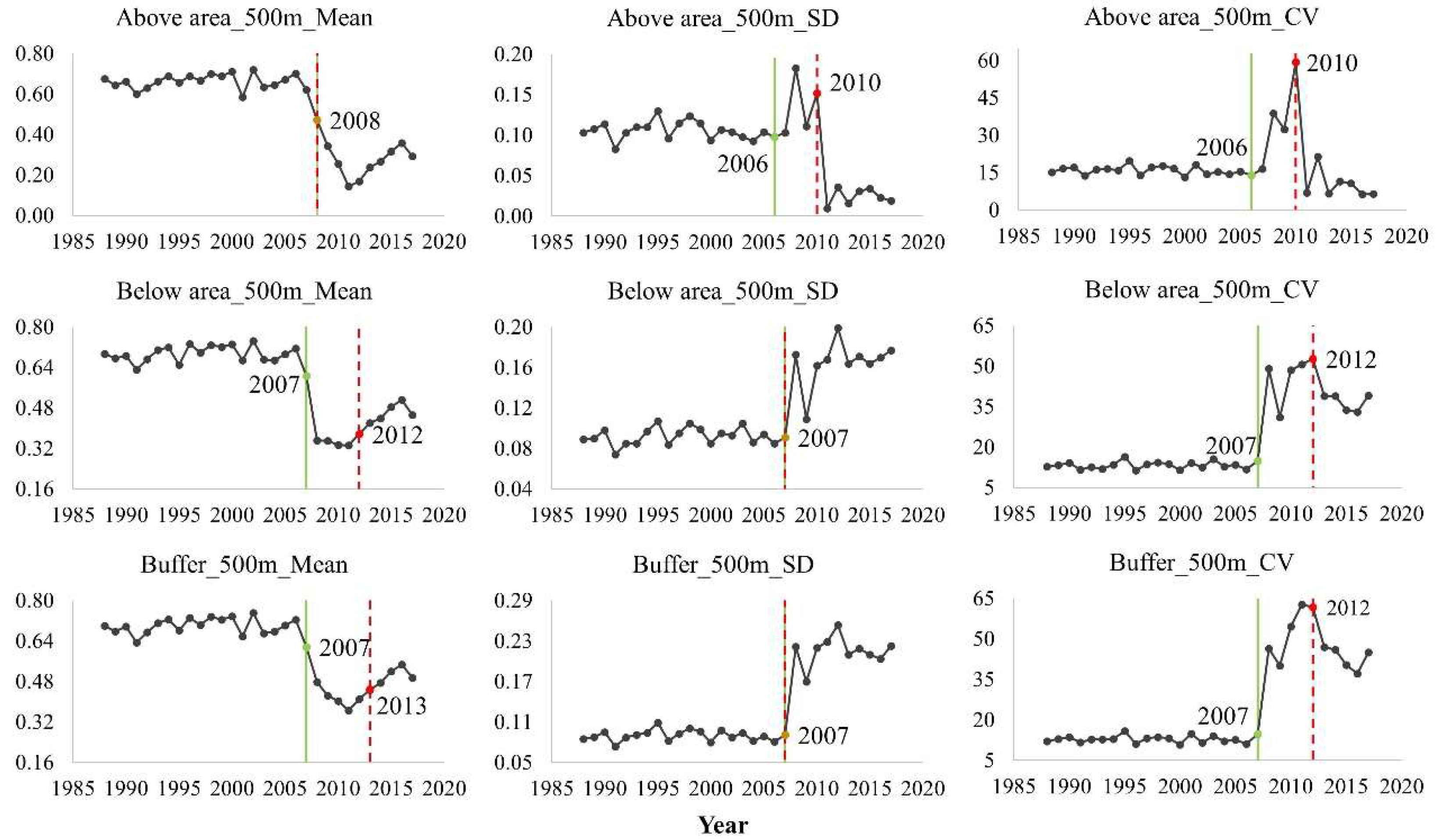
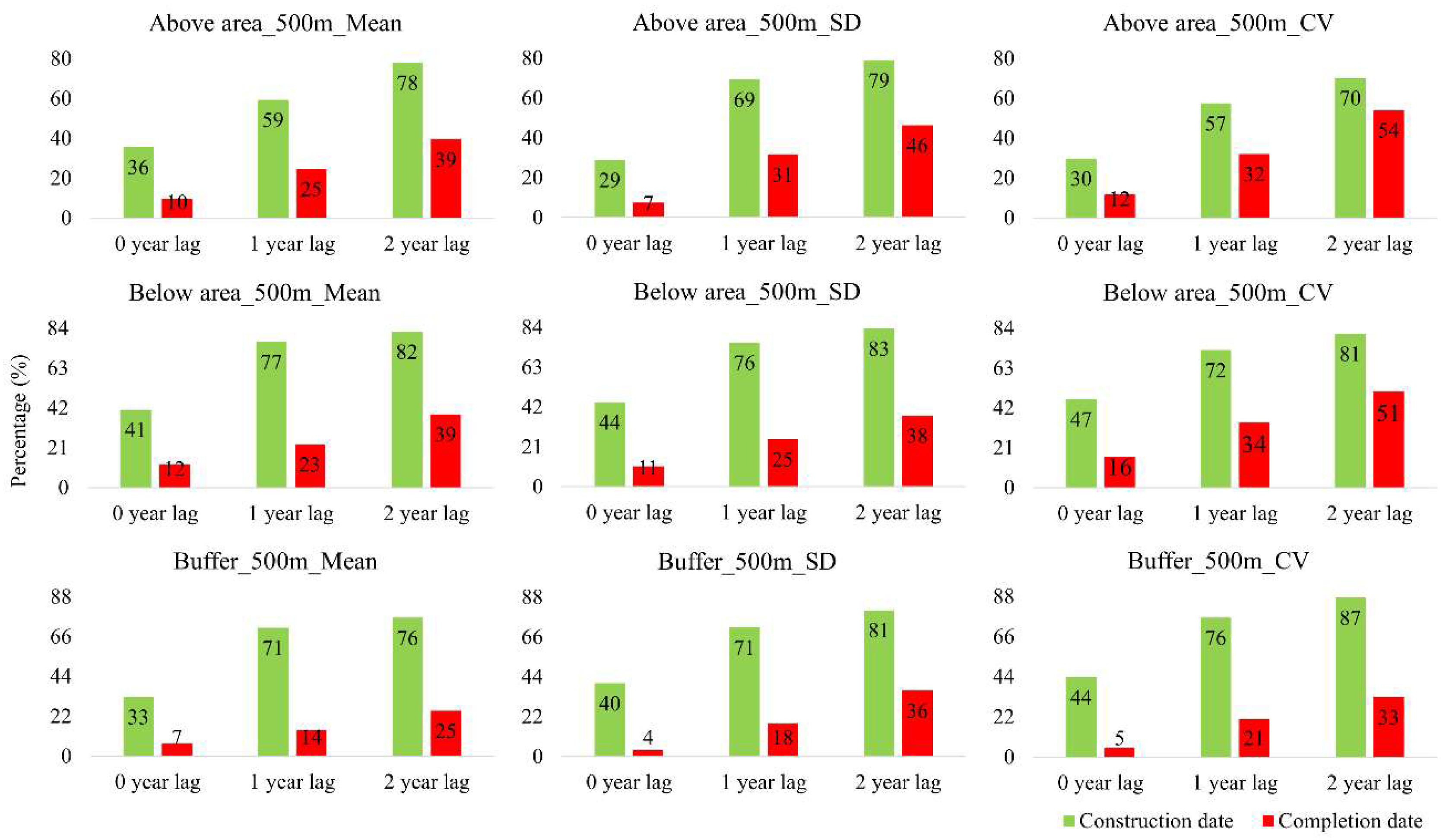
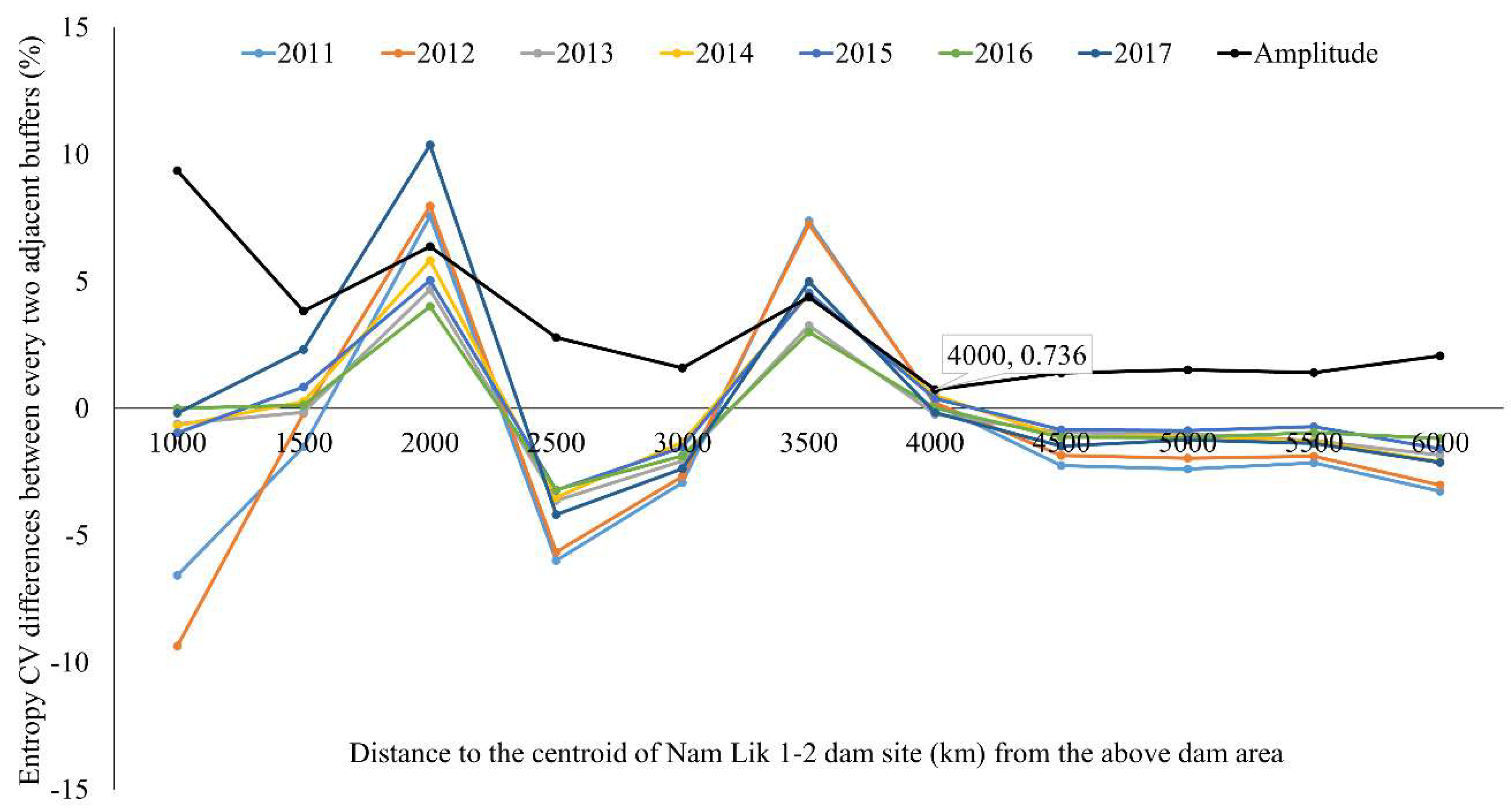
| Status | Total Number of Hydropower Dams |
|---|---|
| Commissioned | 102 |
| Planned | 78 |
| Proposed | 15 |
| Under construction | 41 |
| Project Name | ID | Construction Start Year | Completion Year | Project Name | ID | Construction Start Year | Completion Year |
|---|---|---|---|---|---|---|---|
| A Luoi | 0 | 2007 | 2012 | Nam Ngeip 3A | 34 | 2011 | 2014 |
| Buôn Kốp | 1 | 2003 | 2009 | Nam Ngiep 2 | 35 | 2011 | 2015 |
| Buon Tua Srah | 2 | 2004 | 2009 | Nam Ngum 2 | 36 | 2005 | 2011 |
| Dachaoshan | 3 | 1997 | 2003 | Nam Ngum 5 | 37 | 2008 | 2012 |
| Dak Doa | 4 | 2008 | 2011 | Nam Ou 2 | 38 | 2012 | 2016 |
| Dak Ne | 5 | NR * | 2009 | Nam Ou 5 | 39 | 2012 | 2016 |
| Dak N’Teng | 6 | 2009 | 2011 | Nam Ou 6 | 40 | 2012 | 2016 |
| Dak Po | 7 | NR * | 2015 | Nam San 3A | 41 | 2012 | 2015 |
| Dak Psi 3 | 8 | 2008 | 2012 | Nam San 3B | 42 | 2012 | 2015 |
| Dak Psi 4 | 9 | NR * | 2007 | Nam Song Diversion | 43 | 1995 | 1996 |
| Dak Psi 5 | 10 | 2008 | 2010 | Nam Theun 2 | 44 | 2005 | 2009 |
| Dak Ro Sa | 11 | 2003 | 2007 | Nan Rong Tian | 45 | 2014 | 2015 |
| Dak Ru | 12 | 2006 | 2008 | Nanhe 1 | 46 | 2006 | 2009 |
| Dray Hinh 2 | 13 | 2003 | 2007 | Nuozadu | 47 | 2004 | 2014 |
| Gongguoqiao | 14 | 2009 | 2012 | Pak Mun | 48 | 1990 | 1994 |
| GuaLanZi | 15 | 2013 | 2016 | Plei Krong | 49 | 2003 | 2009 |
| GuoDuo | 16 | 2012 | 2015 | Sesan 3 | 50 | 2002 | 2006 |
| Houay Ho | 17 | 1993 | 1999 | Sesan 3A | 51 | 2003 | 2007 |
| Houay Lamphan Gnai | 18 | 2010 | 2015 | Sesan 4 | 52 | 2004 | 2009 |
| Hua Na | 19 | 1992 | 1995 | Sesan 4A | 53 | 2007 | 2013 |
| Jinfeng | 20 | 1997 | 1998 | Sre Pok 3 | 54 | 2005 | 2009 |
| Jinghong | 21 | 2003 | 2009 | Sre Pok 4 | 55 | 2008 | 2010 |
| Jinhe | 22 | 2001 | 2004 | Theun-Hinboun | 56 | 1994 | 1998 |
| Longdi | 23 | NR * | 2007 | Theun-Hinboun exp. | 57 | 2008 | 2013 |
| Longqingxia | 24 | NR * | 2006 | Upper Kontum | 58 | 2010 | 2014 |
| Lower Sesan 2 | 25 | 2014 | 2017 | Xe Kaman 1 | 59 | 2011 | 2016 |
| Miaowei | 26 | 2009 | 2016 | Xe Kaman 3 | 60 | 2006 | 2011 |
| Nam Beng | 27 | 2010 | 2016 | Xekaman-Sanxay | 61 | 2011 | 2017 |
| Nam Khan 2 | 28 | 2011 | 2015 | Xeset 2 | 62 | 2005 | 2009 |
| Nam Khan 3 | 29 | 2012 | 2016 | Xiangda | 63 | 2006 | 2007 |
| Nam Leuk | 30 | 1996 | 2000 | Xiaowan | 64 | 2002 | 2010 |
| Nam Lik 1-2 | 31 | 2007 | 2011 | XunCun | 65 | 1996 | 1999 |
| Nam Mang 1 | 32 | 2013 | 2016 | Yali | 66 | 1993 | 2000 |
| Nam Mang 3 | 33 | 2002 | 2004 |
| Radius Length (m) | Above Area | Below Area | Buffer | |
|---|---|---|---|---|
| 200 | 0.83 | 0.81 | 0.82 | |
| 300 | 0.75 | 0.71 | 0.69 | |
| Mean | 400 | 0.76 | 0.96 | 0.67 |
| 500 | 0.73 | 0.94 | 0.72 | |
| 600 | 0.70 | 0.68 | 0.69 | |
| 700 | 0.70 | 0.61 | 0.67 | |
| 200 | 0.88 | 0.88 | 0.77 | |
| 300 | 0.87 | 0.66 | 0.94 | |
| Standard Deviation (SD) | 400 | 0.86 | 0.84 | 0.89 |
| 500 | 0.93 | 0.89 | 0.89 | |
| 600 | 0.64 | 0.83 | 0.87 | |
| 700 | 0.69 | 0.76 | 0.93 | |
| 200 | 0.57 | 0.89 | 0.85 | |
| 300 | 0.66 | 0.87 | 0.84 | |
| Coefficient of variation (CV) | 400 | 0.89 | 0.82 | 0.86 |
| 500 | 0.58 | 0.85 | 0.88 | |
| 600 | 0.49 | 0.72 | 0.75 | |
| 700 | 0.78 | 0.73 | 0.78 |
| Radius Length (m) | Above Area | Below Area | Buffer | |
|---|---|---|---|---|
| 200 | 0.66 | 0.67 | 0.71 | |
| 300 | 0.71 | 0.55 | 0.55 | |
| Mean | 400 | 0.71 | 0.81 | 0.51 |
| 500 | 0.69 | 0.78 | 0.56 | |
| 600 | 0.66 | 0.53 | 0.57 | |
| 700 | 0.63 | 0.47 | 0.54 | |
| 200 | 0.80 | 0.76 | 0.69 | |
| 300 | 0.83 | 0.55 | 0.86 | |
| Standard Deviation (SD) | 400 | 0.78 | 0.74 | 0.84 |
| 500 | 0.90 | 0.75 | 0.85 | |
| 600 | 0.71 | 0.71 | 0.81 | |
| 700 | 0.70 | 0.61 | 0.85 | |
| 200 | 0.51 | 0.77 | 0.76 | |
| 300 | 0.63 | 0.79 | 0.78 | |
| Coefficient of variation (CV) | 400 | 0.88 | 0.64 | 0.79 |
| 500 | 0.61 | 0.57 | 0.81 | |
| 600 | 0.61 | 0.59 | 0.77 | |
| 700 | 0.77 | 0.54 | 0.73 |
| Influencing Distance at the Above Dam Area (km) | Number of Hydropower Dams |
|---|---|
| 2.0 | 2 |
| 2.5 | 10 |
| 3 | 11 |
| 3.5 | 6 |
| 4.0 | 17 |
| 4.5 | 3 |
| 5.0 | 10 |
| 5.5 | 6 |
| Influencing Distance Below the Dam Area (km) | Number of Hydropower Dams |
|---|---|
| 1.5 | 3 |
| 2.0 | 4 |
| 2.5 | 13 |
| 3 | 7 |
| 3.5 | 11 |
| 4.0 | 9 |
| 4.5 | 5 |
| 5.0 | 10 |
| 5.5 | 3 |
| Project Name | ID | Installed Capacity (MW) | Influencing Distance Above the Dam Area (km) | Project Name | ID | Installed Capacity (MW) | Influencing Distance Above the Dam Area (km) |
|---|---|---|---|---|---|---|---|
| A Luoi | 0 | 170 | 4.0 | Nam Ngeip 3A | 34 | 44 | 3.0 |
| Buôn Kốp | 1 | 280 | 4.0 | Nam Ngiep 2 | 35 | 180 | 5.5 |
| Buon Tua Srah | 2 | 86 | 2.5 | Nam Ngum 2 | 36 | 615 | 5.0 |
| Dachaoshan | 3 | 1350 | 5.0 | Nam Ngum 5 | 37 | 120 | 4.0 |
| Dak Doa | 4 | 14 | 3.0 | Nam Ou 2 | 38 | 120 | 4.0 |
| Dak Ne | 5 | 13 | 4.0 | Nam Ou 5 | 39 | 240 | 5.5 |
| Dak N’Teng | 6 | 15 | 2.5 | Nam Ou 6 | 40 | 180 | 5.0 |
| Dak Po | 7 | 45 | 2.5 | Nam San 3A | 41 | 69 | 3.0 |
| Dak Psi 3 | 8 | 10 | 3.0 | Nam San 3B | 42 | 45 | 5.5 |
| Dak Psi 4 | 9 | 7.5 | 3.0 | Nam Song Diversion | 43 | 6 | 2.5 |
| Dak Psi 5 | 10 | 12 | 3.5 | Nam Theun 2 | 44 | 1075 | 3.0 |
| Dak Ro Sa | 11 | 16 | 3.0 | Nan Rong Tian | 45 | 8 | 2.5 |
| Dak Ru | 12 | 4.8 | 2.0 | Nanhe 1 | 46 | 40 | 3.0 |
| Dray Hinh 2 | 13 | 900 | 5.0 | Nuozadu | 47 | 5850 | 5.5 |
| Gongguoqiao | 14 | 4.8 | 2.5 | Pak Mun | 48 | 136 | 3.5 |
| GuaLanZi | 15 | 160 | 5.0 | Plei Krong | 49 | 100 | 3.0 |
| GuoDuo | 16 | 152.1 | 4.0 | Sesan 3 | 50 | 260 | 5.0 |
| Houay Ho | 17 | 88 | 3.0 | Sesan 3A | 51 | 96 | 4.0 |
| Houay Lamphan Gnai | 18 | NR * | 4.0 | Sesan 4 | 52 | 360 | 4.0 |
| Hua Na | 19 | 16 | 2.5 | Sesan 4A | 53 | 63 | 4.0 |
| Jinfeng | 20 | 1750 | 4.5 | Sre Pok 3 | 54 | 220 | 3.5 |
| Jinghong | 21 | 60 | 3.5 | Sre Pok 4 | 55 | 600 | 3.0 |
| Jinhe | 22 | 10.08 | 2.5 | Theun-Hinboun | 56 | 220 | 4.5 |
| Longdi | 23 | 16 | 2.5 | Theun-Hinboun exp. | 57 | 222 | 5.0 |
| Longqingxia | 24 | 1670 | 5.0 | Upper Kontum | 58 | 250 | 5.0 |
| Lower Sesan 2 | 25 | 1400 | NA ** | Xe Kaman 1 | 59 | 290 | 4.0 |
| Miaowei | 26 | 36 | 2.0 | Xe Kaman 3 | 60 | 250 | 5.5 |
| Nam Beng | 27 | 130 | 5.5 | Xekaman-Sanxay | 61 | 45 | NA ** |
| Nam Khan 2 | 28 | 60 | 3.5 | Xeset 2 | 62 | 76 | 2.5 |
| Nam Khan 3 | 29 | 1.5 | 4.0 | Xiangda | 63 | 0.8 | 4.5 |
| Nam Leuk | 30 | 60 | 4.0 | Xiaowan | 64 | 4200 | 4.0 |
| Nam Lik 1-2 | 31 | 100 | 4.0 | XunCun | 65 | 78 | 3.5 |
| Nam Mang 1 | 32 | 64 | 4.0 | Yali | 66 | 720 | 4.0 |
| Nam Mang 3 | 33 | 40 | 5.0 |
| Project Name | ID | Installed Capacity (MW) | Influencing Distance Below the Dam Area (km) | Project Name | ID | Installed Capacity (MW) | Influencing Distance Below the Dam Area (km) |
|---|---|---|---|---|---|---|---|
| A Luoi | 0 | 170 | 4.0 | Nam Ngeip 3A | 34 | 44 | 3.5 |
| Buôn Kốp | 1 | 280 | 3.5 | Nam Ngiep 2 | 35 | 180 | 4.5 |
| Buon Tua Srah | 2 | 86 | 2.5 | Nam Ngum 2 | 36 | 615 | 5.5 |
| Dachaoshan | 3 | 1350 | 3.5 | Nam Ngum 5 | 37 | 120 | 4.5 |
| Dak Doa | 4 | 14 | 3.0 | Nam Ou 2 | 38 | 120 | 4.0 |
| Dak Ne | 5 | 13 | 4.0 | Nam Ou 5 | 39 | 240 | 5.0 |
| Dak N’Teng | 6 | 15 | 3.0 | Nam Ou 6 | 40 | 180 | 5.0 |
| Dak Po | 7 | 45 | 2.5 | Nam San 3A | 41 | 69 | 2.5 |
| Dak Psi 3 | 8 | 10 | 3.5 | Nam San 3B | 42 | 45 | 5.0 |
| Dak Psi 4 | 9 | 7.5 | 2.0 | Nam Song Diversion | 43 | 6 | 1.5 |
| Dak Psi 5 | 10 | 12 | 2.5 | Nam Theun 2 | 44 | 1075 | 4.0 |
| Dak Ro Sa | 11 | 16 | 2.5 | Nan Rong Tian | 45 | 8 | 2.5 |
| Dak Ru | 12 | 4.8 | 2.0 | Nanhe 1 | 46 | 40 | 3.0 |
| Dray Hinh 2 | 13 | 900 | 5.5 | Nuozadu | 47 | 5850 | 2.0 |
| Gongguoqiao | 14 | 4.8 | 2.5 | Pak Mun | 48 | 136 | 1.5 |
| GuaLanZi | 15 | 160 | 5.5 | Plei Krong | 49 | 100 | 3.5 |
| GuoDuo | 16 | 152.1 | 5.0 | Sesan 3 | 50 | 260 | 2.5 |
| Houay Ho | 17 | 88 | 2.5 | Sesan 3A | 51 | 96 | 3.5 |
| Houay Lamphan Gnai | 18 | NR * | 4.0 | Sesan 4 | 52 | 360 | 3.0 |
| Hua Na | 19 | 16 | 2.0 | Sesan 4A | 53 | 63 | 3.5 |
| Jinfeng | 20 | 1750 | 5.0 | Sre Pok 3 | 54 | 220 | 4.0 |
| Jinghong | 21 | 60 | 2.5 | Sre Pok 4 | 55 | 600 | 3.5 |
| Jinhe | 22 | 10.08 | 3.0 | Theun-Hinboun | 56 | 220 | 4.0 |
| Longdi | 23 | 16 | 2.5 | Theun-Hinboun exp. | 57 | 222 | 5.0 |
| Longqingxia | 24 | 1670 | 5.0 | Upper Kontum | 58 | 250 | 4.5 |
| Lower Sesan 2 | 25 | 1400 | NA ** | Xe Kaman 1 | 59 | 290 | 4.5 |
| Miaowei | 26 | 36 | 1.5 | Xe Kaman 3 | 60 | 250 | 5.0 |
| Nam Beng | 27 | 130 | 5.0 | Xekaman-Sanxay | 61 | 45 | NA** |
| Nam Khan 2 | 28 | 60 | 3.5 | Xeset 2 | 62 | 76 | 2.5 |
| Nam Khan 3 | 29 | 1.5 | 3.5 | Xiangda | 63 | 0.8 | 3.0 |
| Nam Leuk | 30 | 60 | 4.0 | Xiaowan | 64 | 4200 | 5.0 |
| Nam Lik 1-2 | 31 | 100 | 3.5 | XunCun | 65 | 78 | 2.5 |
| Nam Mang 1 | 32 | 64 | 4.5 | Yali | 66 | 720 | 4.0 |
| Nam Mang 3 | 33 | 40 | 3.0 |
© 2019 by the authors. Licensee MDPI, Basel, Switzerland. This article is an open access article distributed under the terms and conditions of the Creative Commons Attribution (CC BY) license (http://creativecommons.org/licenses/by/4.0/).
Share and Cite
Lin, Z.; Qi, J. A New Remote Sensing Approach to Enrich Hydropower Dams’ Information and Assess Their Impact Distances: A Case Study in the Mekong River Basin. Remote Sens. 2019, 11, 3016. https://doi.org/10.3390/rs11243016
Lin Z, Qi J. A New Remote Sensing Approach to Enrich Hydropower Dams’ Information and Assess Their Impact Distances: A Case Study in the Mekong River Basin. Remote Sensing. 2019; 11(24):3016. https://doi.org/10.3390/rs11243016
Chicago/Turabian StyleLin, Zihan, and Jiaguo Qi. 2019. "A New Remote Sensing Approach to Enrich Hydropower Dams’ Information and Assess Their Impact Distances: A Case Study in the Mekong River Basin" Remote Sensing 11, no. 24: 3016. https://doi.org/10.3390/rs11243016
APA StyleLin, Z., & Qi, J. (2019). A New Remote Sensing Approach to Enrich Hydropower Dams’ Information and Assess Their Impact Distances: A Case Study in the Mekong River Basin. Remote Sensing, 11(24), 3016. https://doi.org/10.3390/rs11243016







